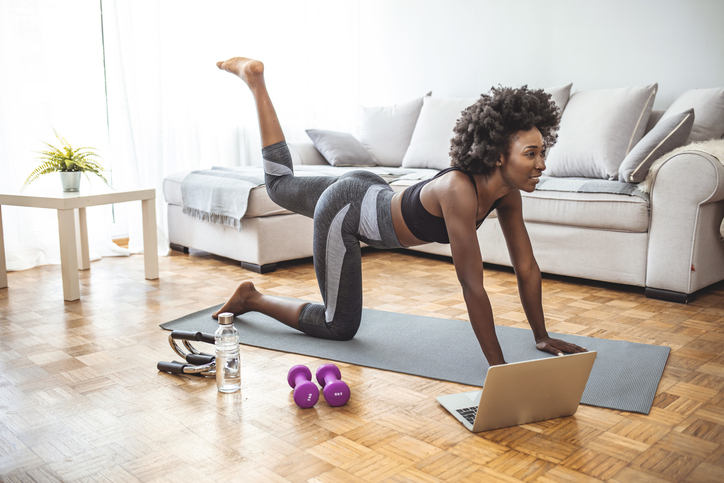While our minds continue to navigate the pandemic and its effects, our bodies have been frantically trying to get to grips with something new, too: at-home workouts.
With facilities closed and social distancing enforced during lockdown, research* indicates more than half of us started working out in the comfort of our living rooms – and that three quarters of this figure has continued to do so in the months that followed. The wonder of the internet certainly made it easy to and, while our efforts to stay fit should be applauded, it’s not all been good news. Left to our own devices, bad habits – from skipping warm-ups to exercising in slippers – have had the opportunity to take hold. If allowed to continue, these can hinder progress and even cause injury, so to help stop them in their tracks, we’ve spoken to the leading fitness experts to discover some common mistakes we’re making – and how to fix them.
We’re easily distracted
It’s easy to maintain a more disciplined mindset at the gym, whereas distractions – from the TV to your kids – can quickly derail your exercise routine at home. “We believe we can do our exercises while still attached to our phones. Can you imagine flicking through Instagram when you’re working out with a fitness expert?” asks personal trainer Ross Styles (rossstyles.com). To help maintain your focus, Styles suggests writing down a routine before you start, as this gives you something to stick to and work towards completing. And another piece of advice? Hide your phone, natch.
We don’t streeeetch
Faced with a packed schedule, it’s oh-so-tempting to ditch the warm-up and save a bit of time. Be warned: “Jumping straight into a workout without any sort of preparation is just asking for an injury,” says Michael Ulloa, personal trainer and performance nutritionist (he’s @michaelulloapt on Instagram). The good news is that a warm-up routine needn’t be complicated or lengthy; 10 minutes is plenty. “If you’re unsure where to start, simply begin by doing slower, more controlled movements of exercises that are within the workout ahead.” Steady squats could be one move to try.“Standing hip rotations – bringing one knee up in front of you then turning out to the side is another good stretch,” he adds.
We don’t listen to our bodies
It can be easy to push through niggles and twinges when training solo, as there’s nobody around to discuss them with or tell you to stop – so tune into your body to offset this. “When you exercise at home, listening to your body and what feels right is so important,” says women’s fitness coach Sarah Scudamore (mumology-movement. mykajabi.com). In the absence of a personal trainer or gym buddy, coach yourself. “You need to be your own instructor. Simply listening to your body as you move will help you work within your boundaries,” Sarah explains. If a particular exercise is causing pain or discomfort, don’t push yourself. You always have options, so stop and go with a different movement.
We lack the right equipment
Hooray for bodyweight exercises! They’re free and you can do them anywhere. However, don’t be scared of weights. “Using equipment takes your home workout to the next level,” notes Amy Brogan, personal trainer and founder of A Body Forever (abodyforever.com). “It’s impossible to build strength without resistance; there’s no ‘push’ or ‘pull’ without it.” A few basics will set you up for a plethora of workouts, such as one set of light weights and one set of medium weights. Resistance bands are also effective and take up very little space, while a humble skipping rope is perfect for adding a bit of (dare we say it) fun to your cardio routine.
We stick to the same routine
We’re all for finding workouts we love, but it’s important to mix things up. “Variation is the cornerstone of total body strength, functionality and progress,” says Amy. “You’d be surprised at how quickly your body gets used to a workout.” How to avoid the dreaded plateau? “It’s important to push yourself and keep your body on its toes,” she explains. This doesn’t mean you have to do something you don’t enjoy, but look for different videos, increase to the next set of weights or alternate exercise types between days.
We don’t wear the correct shoes
Nobody wants to wear muddy trainers indoors, so going barefoot is okay, right? Not so much. “Exercising barefoot is fine for low-impact workouts, such as yoga and Pilates,” explains Mandy Wong Oultram, award-winning personal trainer at FlexFit (flexfitpt.com). “However, the danger lies when people skip putting on their trainers for higher impact exercises, such as those that involve running and jumping.” Not having the proper foot support can put extra pressure on joints and muscles, which of course increases your risk of injuries. “The right shoe can mean the difference between an efficient and ineffective workout performance,” Mandy adds.
We’re not focused on good form
Maintaining proper form is vital to avoid injury and get the most out of exercises – but without wall-to-wall mirrors or a workout pal, it can be tricky to know if your technique is awry. “We can fall into bad habits, such as your knees going over your toes when squatting,” shares Lucy Arnold, founder of bestselling activewear brand Lucy Locket Loves (locketloves.com). “Try exercising in front of a full-length mirror, or videoing yourself to make sure you are doing exercises right.Take the time to watch what you’re doing.”
We don’t mentally prepare
Without that journey to the gym, your brain doesn’t have a chance to switch into workout mode and get psyched up. “If we don’t feel mentally ready, motivated and capable as soon as we start a workout, we feel disheartened, a failure and unable to ‘get into the zone’,” says Sara Clarke, founder of the Fitting in Fitness app (fittinginfitness.co.uk). So, take steps to help rev up that transition and mentally prepare for movement. Sara suggests incorporating motivational decor into your at-home workout space or pausing to recognise why you’re taking the time to exercise. And don’t stop there: she also recommends setting goals or targets, as this encourages effort and keeps you accountable.



















